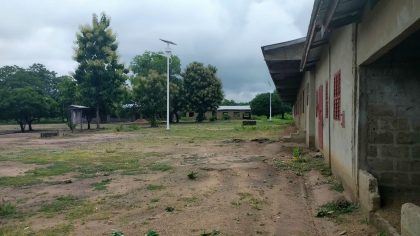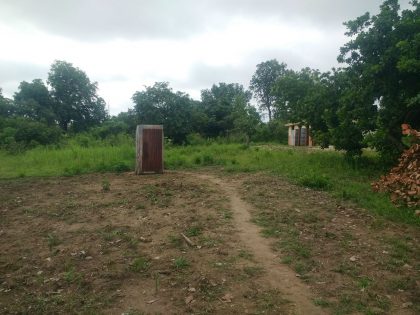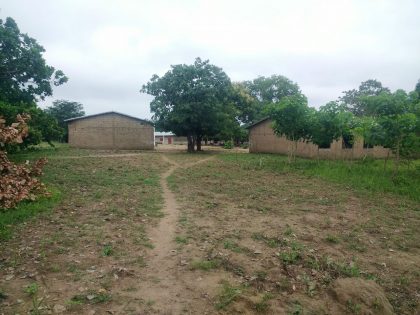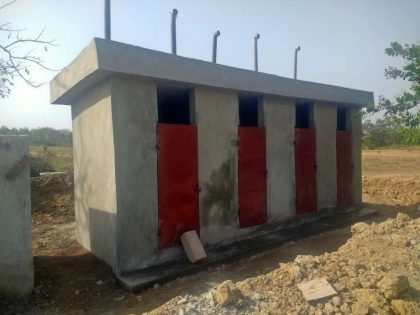This project is made possible through the partnership of WATER CHARITY and the NATIONAL PEACE CORPS ASSOCIATION. ![]()
This project has been completed. Please scroll down the page to read about the conclusion.
 Location
Location
Gxxxxxx, Commune of Ouesse, Benin
The exact location has been redacted for security reasons.
Community Description
Gxxxxxx is a community in the commune of Ouesse, Benin. Ouesse is a large agricultural commune, where most people are farmers or tradesmen. Gbanlin is the largest town besides Ouesse, which is the commune head.
The main exports are yams, cotton, peanuts, and corn. This result is the community being extremely poor, with most people living easily on less than a dollar per day. There is very limited running water, and no electricity.
With seven months of the dry season, there is no work for people the majority of the year, and therefore, almost all the students help their families with intense farm work for five months while the rains fall. This period often overlaps with the last month of the school year, resulting in many students dropping out of class.
Diets are very simple, and life moves slowly. There is little infrastructure and almost no vehicles on the dirt roads. However, despite these challenges, the people of Gxxxxxx have succeeded in building a thriving community on the outskirts of Ouesse, with regular markets, a consistent source of water, health centers, churches, and a school.
 In the region, there are six general education schools, which hold students from age 10 until they go to University, roughly the equivalent of middle and high school. Gxxxxxx has a population of roughly 8,000 people, and the school, CEG Gbanlin, enrolls around 1,000 students at a time. Most of the students live in the nearby towns of Gbanlin, Tosso, or Vossa.
In the region, there are six general education schools, which hold students from age 10 until they go to University, roughly the equivalent of middle and high school. Gxxxxxx has a population of roughly 8,000 people, and the school, CEG Gbanlin, enrolls around 1,000 students at a time. Most of the students live in the nearby towns of Gbanlin, Tosso, or Vossa.
Problem Addressed
The school has 18 classroom buildings, a library, an administrative block, and a set of broken latrines. With no functional facilities, the students all go into the woods to defecate, resulting in a massive quantity of human waste accumulating behind the school. Students sometimes miss upwards of 15 minutes of class time in order to relieve themselves.
Furthermore, teachers are forbidden by cultural norms to defecate back in the woods, so when teachers are at school, there is no place for them to go. There are also several groups of houses around the school, and exposed fecal matter can easily lead to insect-borne diseases among the local population.
Project Description
This project is to build a 4-cabin latrine facility on campus.
A reputable contractor from Ouesse from the company “AAA”, pronounces “Trois Aces” has been chosen to do the work. A location not far from the old latrines, about 100 yards from the nearest classroom, has been selected.
The funds from the Water Charity will be going to provide 75% of the money needed for the project, including paying for cement, iron bars, iron wire, nails, metal doors, PVC pipe, gravel, formwork wood, the price of excavation, transport of materials, and part of the labor costs.
The community will provide the sand and the water for the concrete, in addition to subsidizing the labor costs, through both in-kind and cash contributions.
 Project Impact
Project Impact
This project will directly benefit the 1,000 students, 85 teachers, and 6 staff, and will indirectly benefit an additional 5,000 family members.
Peace Corps Volunteer Directing Project
Ian Schwenke
Monitoring and Maintenance
The sustainability of this project is based on the solid and sturdy construction of the latrines on the school grounds. The project is based on a durable and sustainable design and will be carried out by a respected contractor. These latrines are expected to last for many years.
The school administration will make sure the latrines are cleanly, and, as with the rest of the school, regularly weeded, with the grounds around them cleared of debris. The student body will be educated on proper latrine usage.
Project Funding
This project has been paid for by an anonymous donor.
Conclusion of CEG Gbanlin Latrine Project – Benin
 This project has been completed by Peace Corps Volunteer Ian Schwenke. Ian reports:
This project has been completed by Peace Corps Volunteer Ian Schwenke. Ian reports:
The project at CEG Gbanlin for the construction of latrines has now been completed and I am in the process of closing out the grant with the Peace Corps. It was designed to tackle one of the biggest problems at our middle/high school for general education in central Benin, the lack of toilet facilities and resulting in hygiene problems.
The project’s goal was to construct a building with 4 latrine cabins inside. The latrines are to be durable and sustainable, with solid construction and removable back panels for easy cleaning after a period of several years. The school provided 25% of the construction costs, and we found a reputable local contractor who had experience with previous Peace Corps Volunteers to do the work. The construction was carried out during the months of September, October, and November.
The school community, including the students, spent time collecting gravel, sand, and water to mix with the concrete that was brought in from a nearby town by the contractor. The first step was to make bricks for the building, while a separate team excavated the construction site.
Over the next few weeks, more materials and workers were brought in to construct the latrines from the bottom chambers to the actual cabins above-ground. Covering on the top provides a secure area against the elements, and the cabins are properly ventilated with window slots and PVC pipes. There are locks on every door so that the facilities may not be used while school is not in session. There are removable panels behind the latrines that lead to the chambers underneath which will allow the school to clean out the latrines when the time comes, to avoid building all new cabins in a different area.
The school, community, and students were all very receptive to the latrines and have begun using them. There was a brief inauguration ceremony with the students, administration, community members and the contractor to explain the project and the proper usage of the facility.
The usage of the latrines will be monitored over the first few months of 2019 to ensure students and community members are properly using the cabins and that upkeep is as it should be. These latrines should last at CEG Gbanlin for decades to come and will serve tens of thousands of future students, leading to healthier hygiene practices for the entire community.
The community is incredibly thankful to Water Charity, and the lives of many people will be improved due to these efforts.